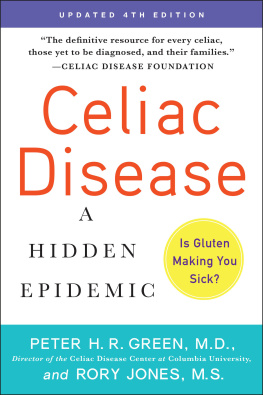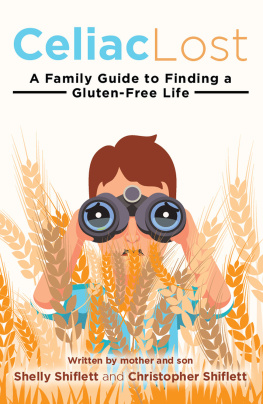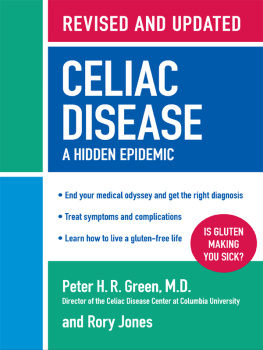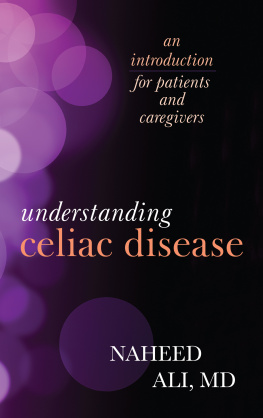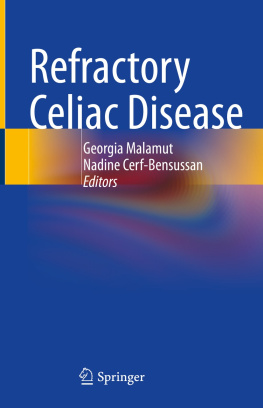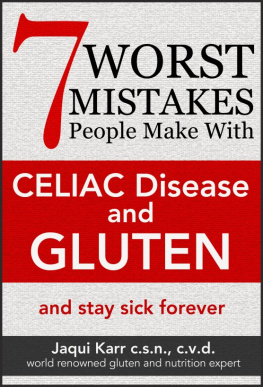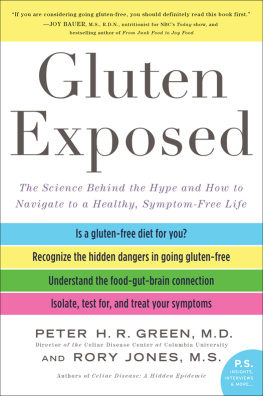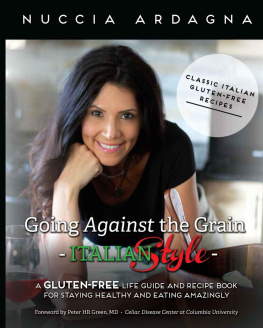Peter H.R. Green - Celiac Disease
Here you can read online Peter H.R. Green - Celiac Disease full text of the book (entire story) in english for free. Download pdf and epub, get meaning, cover and reviews about this ebook. year: 2020, publisher: William Morrow Paperbacks, genre: Romance novel. Description of the work, (preface) as well as reviews are available. Best literature library LitArk.com created for fans of good reading and offers a wide selection of genres:
Romance novel
Science fiction
Adventure
Detective
Science
History
Home and family
Prose
Art
Politics
Computer
Non-fiction
Religion
Business
Children
Humor
Choose a favorite category and find really read worthwhile books. Enjoy immersion in the world of imagination, feel the emotions of the characters or learn something new for yourself, make an fascinating discovery.
- Book:Celiac Disease
- Author:
- Publisher:William Morrow Paperbacks
- Genre:
- Year:2020
- Rating:5 / 5
- Favourites:Add to favourites
- Your mark:
- 100
- 1
- 2
- 3
- 4
- 5
Celiac Disease: summary, description and annotation
We offer to read an annotation, description, summary or preface (depends on what the author of the book "Celiac Disease" wrote himself). If you haven't found the necessary information about the book — write in the comments, we will try to find it.
Celiac Disease — read online for free the complete book (whole text) full work
Below is the text of the book, divided by pages. System saving the place of the last page read, allows you to conveniently read the book "Celiac Disease" online for free, without having to search again every time where you left off. Put a bookmark, and you can go to the page where you finished reading at any time.
Font size:
Interval:
Bookmark:
Check each of the symptoms that you have experienced at least once a week during the past three months:
___ Bloating
___ Gas and/or stomach cramping
___ Diarrhea or runny stools
___ Constipation
___ Joint pain
___ Numbness or tingling in your extremities
___ Itchy skin lesions
___ Constant unexplained fatigue
___ Frequent headaches or migraines
Check if you have had or been diagnosed with any of the following:
___ Irritable bowel syndrome
___ Eczema or unexplained contact dermatitis
___ Fibromyalgia
___ Chronic fatigue syndrome
___ Nervous stomach (non-ulcer dyspepsia)
Check if you have any of the following:
___ Lactose intolerance
___ Osteopenia and/or osteoporosis
___ Autoimmune disorders
___ Thyroid disease (hypo/hyper)
___ Diabetes mellitus (type 1)
___ Sjgrens syndrome
___ Chronic liver disease
___ An immediate family member with an autoimmune condition
___ Peripheral neuropathy
___ Non-Hodgkins lymphoma
___ Small intestinal cancer
___ Psychiatric disorders or depression
___ Anemia (iron deficiency)
___ Infertility
If you have checked one or more lines in either Section I or II and have any of the illnesses in Section III (especially males or women under forty-five with osteopenia and/or osteoporosis), you should consider testing for celiac disease. If you have checks in all three sections, you and your doctor(s) should definitely explore a diagnosis of celiac disease.
All of the symptoms in Section I, all of the diagnoses in Section II, and all of the associated illnesses in Section III are intimately related to celiac disease. One in every 100 people in the United States is affected by celiac diseaseand about 50 percent of them are undiagnosed!
This book evolved from the combination of two sometimes diverse perspectives: that of the doctor and the patient. It incorporates an understanding of both the science and the experience of an illnessand the collective knowledge we both have acquired in the process. This revised fourth edition reflects the current developments in a rapidly changing field.
We would like to thank everyone we have worked and collaborated with over the past number of years, but some deserve a special mention.
I appreciate the frequent interactions with my colleagues in the Celiac Disease Center at Columbia University, especially Amy DeFelice, Ben Lebwohl, Suneeta Krishnareddy, Suzanne Lewis, Anne Lee, Jessica Lebovits, Cynthia Beckman, Govind Bhagat, Ed Ciaccio, and Randi Wolf.
Peter Green, M.D.
There are many people who educated me about celiac disease and dermatitis herpetiformisas well as how to live well with a chronic illness. I am particularly indebted to the many medical professionals, patients, students, and friends who shared their stories that shaped the narratives about living with celiac disease that resonate throughout this book.
As always, my family deserve the deepest thanks for their endless patience and humor, without which nothing would be possible.
Rory Jones
We both want to express special thanks to:
Jennifer Civiletto, our editor, who graciously and tirelessly supplied encouragement and professional guidance; Faith Hamlin, our agent, who championed the book even before she knew that some of her best friends had celiac disease; and Cathy Hemming, whose vision made it possible.
Finally, we want to thank the many patients who so generously gave us their time and shared their insights. This book is for you and the many people living with celiac disease and those making the long journey to diagnosis.
The Celiac Disease Center at Columbia University is one of the few leading centers in the United States that provides comprehensive medical care, including nutritional counseling, for adult and pediatric patients with celiac disease. Its mission is to redefine the future of celiac disease and treatment through continuing advances in research, patient care, and physician and public education. The Center is diagnosing and treating more than two thousand patients annually from around the world. In its nineteen years of operation, the Center owes much to the generous individuals who have assisted us in fulfilling its goals.
All of the information in this book is based on current knowledge about the causes, manifestations, diagnosis, treatment, and consequences of celiac disease. It is derived from an in-depth analysis of current medical literature, extensive clinical experience, patient and professional interviews, as well as ongoing research into celiac disease and its many complications.
Other medical experts may have differing opinions and interpretations of the medical literature. Wherever pertinent, the authors have attempted to note conflicting points of view on key issues as well as topics that have not as yet been scientifically resolved.
Many of the peer review articles we have consulted may not be readily accessible to all readers. For this reason, we have not included footnotes for all medical facts and figures. Instead, we have listed good basic review articles and books for different subjects in the Appendices.
The personal stories and diagnoses throughout this book are based primarily on the patient population seen at the Celiac Disease Center at Columbia University. The population of the greater New York tristate area is very large and ethnically diverse. In addition, the patients who seek help at a major medical center may present with more severe and complex symptoms. We understand that this may or may not be typical of the celiac profile in any given city or region of the United States. Nevertheless, we feel that the cross section of patients chosen for this book reflects the face of celiac disease in the United States today.
Note: This book is not a self-diagnosis manual. It is intended to generate informed patients who know what questions to ask of their physicians and how to understand the answers.
My doctor kept treating my symptoms, but never figured out why my stomach was always upset. I started getting migraines and then joint pain and... well, you name it. I was a walking pharmacy and still felt lousy. (Marg, 47)
My daughter was always tired. It was a joke with her friendswheres Melshes asleep. She slept through classes in college... it affected her social life. We even did an overnight sleep study in the hospitalshe was sleeping fourteen to sixteen hours a day. (Roni)
My daughter had legs like pick-up sticks and an enormous belly and the pediatrician called it baby fat and said shed grow into it. (Mike, 40)
I think people thought I was a hypochondriacthere was so much wrong with me. (Heather, 43)
In the United States today, millions of patients suffer with symptoms that neither fit a specific diagnosis nor disappear. Young and old take drugs and see numerous specialists for gastrointestinal complaints, anemia, joint pain, itchy skin conditions, constant fatigue, or headaches. Their symptoms are treated, but no underlying cause can be found. One doctor diagnoses fibromyalgia, another chronic fatigue syndrome, a third irritable bowel syndrome. Too much or too little roughage, lactose or fructose intolerance, fried or spicy food explains repeated bouts of reflux, diarrhea, constipation, abdominal pain, and gas. Muscle strain or the wrong type of mattress is the excuse for aching joints or tingling extremities that remain asleep when the rest of you wakes up in the morning.
Font size:
Interval:
Bookmark:
Similar books «Celiac Disease»
Look at similar books to Celiac Disease. We have selected literature similar in name and meaning in the hope of providing readers with more options to find new, interesting, not yet read works.
Discussion, reviews of the book Celiac Disease and just readers' own opinions. Leave your comments, write what you think about the work, its meaning or the main characters. Specify what exactly you liked and what you didn't like, and why you think so.

